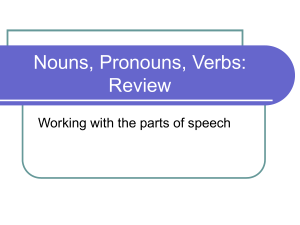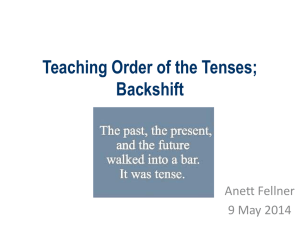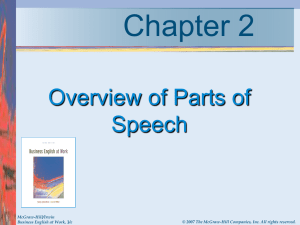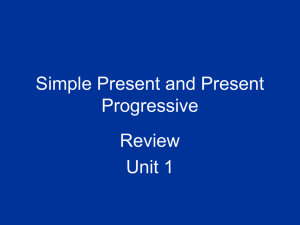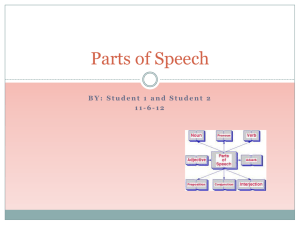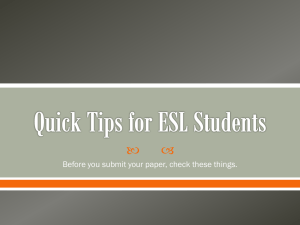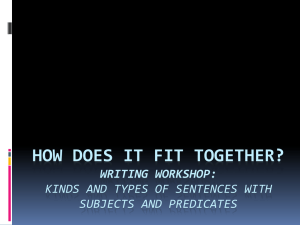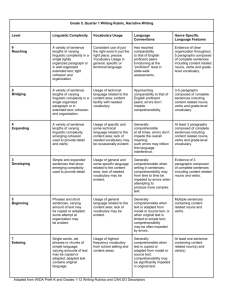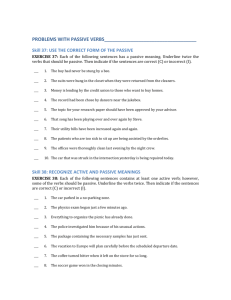Word - BJU Press
advertisement
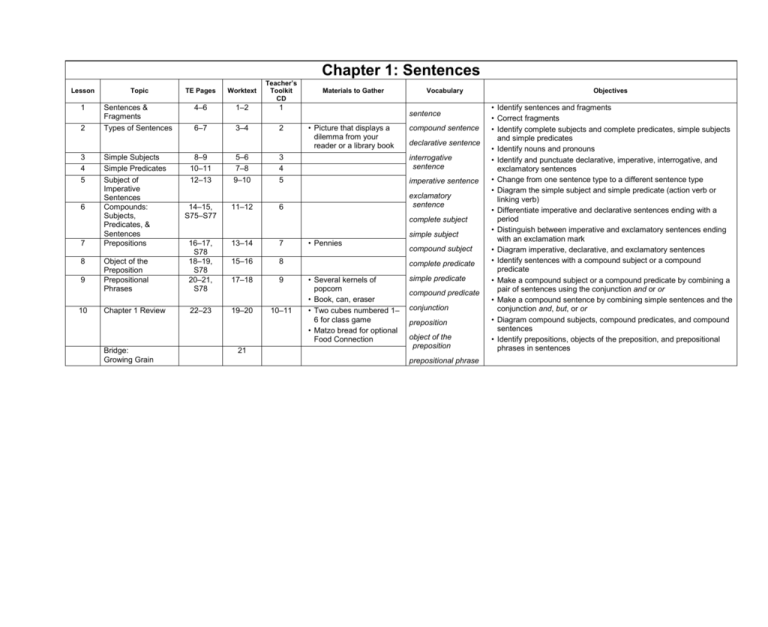
Chapter 1: Sentences Lesson Topic TE Pages Worktext Teacher’s Toolkit CD 1 Sentences & Fragments Types of Sentences 4–6 1–2 1 6–7 3–4 2 2 3 4 5 6 7 8 9 10 Simple Subjects Simple Predicates Subject of Imperative Sentences Compounds: Subjects, Predicates, & Sentences Prepositions 8–9 10–11 12–13 5–6 7–8 9–10 3 4 5 14–15, S75–S77 11–12 6 13–14 7 Object of the Preposition Prepositional Phrases 16–17, S78 18–19, S78 20–21, S78 15–16 8 17–18 9 Chapter 1 Review 22–23 19–20 Bridge: Growing Grain Materials to Gather Vocabulary sentence • Picture that displays a dilemma from your reader or a library book compound sentence declarative sentence interrogative sentence imperative sentence exclamatory sentence complete subject simple subject 21 10–11 • Pennies compound subject complete predicate • Several kernels of popcorn • Book, can, eraser • Two cubes numbered 1– 6 for class game • Matzo bread for optional Food Connection simple predicate compound predicate conjunction preposition object of the preposition prepositional phrase Objectives • Identify sentences and fragments • Correct fragments • Identify complete subjects and complete predicates, simple subjects and simple predicates • Identify nouns and pronouns • Identify and punctuate declarative, imperative, interrogative, and exclamatory sentences • Change from one sentence type to a different sentence type • Diagram the simple subject and simple predicate (action verb or linking verb) • Differentiate imperative and declarative sentences ending with a period • Distinguish between imperative and exclamatory sentences ending with an exclamation mark • Diagram imperative, declarative, and exclamatory sentences • Identify sentences with a compound subject or a compound predicate • Make a compound subject or a compound predicate by combining a pair of sentences using the conjunction and or or • Make a compound sentence by combining simple sentences and the conjunction and, but, or or • Diagram compound subjects, compound predicates, and compound sentences • Identify prepositions, objects of the preposition, and prepositional phrases in sentences Chapter 2: Writing a Compare-Contrast Essay Lesson Topic TE Pages Worktext 25 22 11 Bridge: Linking Literature to Writing Paragraphs That Make Sense Compare-Contrast Essays 28–29 23–24 30–31 25–26 12 13 14 19 Descriptive Words Compare-Contrast Essay: Planning Compare-Contrast Essay: Drafting Compare-Contrast Essay: Revising Compare-Contrast Essay: Proofreading Compare-Contrast Essay: Publishing Chapter 2 Review 20 Cumulative Review 15 16 17 18 Teacher’s Toolkit CD Materials to Gather Vocabulary paragraph introduction • Football and baseball (or any two different types of balls) topic sentence comparison 32–33 34–35, S79 36–37, S79 38–39 27–28 29–30 contrast 31–32 comparing words 40–41 35–36 conclusion contrasting words 33–34 descriptive words synonyms • Poster board for each student (optional) 42–43 44–45, S80 46–47 37–38 12–13 antonyms T-chart Venn diagram 39–40 Writing Process planning drafting revising proofreading publishing Objectives • • • • • • • • • • • • • • • • • Identify the topic sentence of a paragraph Recognize logical structure in paragraphs Distinguish between comparing and contrasting Identify sentences that do not belong in a paragraph Insert comparing and contrasting words at appropriate places in an essay Identify the parts of a model essay Plan, draft, revise, and proofread a compare-contrast essay together Recognize the thesaurus as a source of descriptive words Identify the stages of the Writing Process Choose a topic for a compare-contrast essay List details about two subjects Organize details in a Venn diagram Analyze the student model Recall the purpose of each paragraph in a compare-contrast essay Participate in a writing conference Recognize errors using a Proofreading Checklist Draft, revise, proofread, publish, and illustrate a compare-contrast essay Chapter 3: Nouns Lesson Topic TE Pages Worktext Teacher’s Toolkit CD 21 Nouns: Common & Proper Proper Nouns: Capitalization Rules Abbreviations 50–51, S81 52–53 41–42 14 43–44 15 54–55 45–46 16 Common Nouns: Singular & Plural Common Nouns: Special Plurals Possessive Nouns: Singular Possessive Nouns: Plural Language Link: (Punctuation) Using Commas Chapter 3 Review 56–57 47–48 17 58–59 49–50 18 60–61 51–52 19 62–63 53–54 20 plural possessive noun 64–65, S82–S83 55–56 21 singular possessive noun 66–67 57–58 22–23 68–69 70 59–60 61 22 23 24 25 26 27 28 29 30 Cumulative Review Bridge: Visiting Natural History Museums Materials to Gather Vocabulary noun common noun • Ingredients for Bag of Fudge (optional) proper noun abbreviation singular noun plural noun • Some items belonging to the students • Items for optional Science Connection possessive noun commas Objectives • Identify nouns that name a person, place, thing, idea, or feeling • Distinguish between common and proper nouns and singular and plural nouns • Distinguish between nouns used as subjects and nouns used as objects • Capitalize proper nouns and titles of poems, stories, and books • Identify words that become proper nouns based on their usage • Write and identify abbreviations for months, days, titles, times, metric measurement units, and customary measurement units • Form plural nouns by adding s or es to singular nouns • Write plural forms for nouns ending in y, o, f, or fe • Identify correct spellings of plural nouns • Identify nouns that form their plurals by changing their spellings and those that do not change their spellings • Identify singular possessive nouns and plural possessive nouns • Write possessive forms of plural nouns • Use commas correctly in parts of a letter and in sentences with a series, an appositive, an introductory word, or a long introductory phrase; in dialogue; in direct address; and in a compound sentence Chapter 4: Writing a Persuasive Business Letter Lesson Topic TE Pages Worktext 71 62 31 32 Bridge: Linking Literature to Writing Persuasive Writing Dishonest Tactics 74–75 76–77 63–64 65–66 33 34 35 36 37 38 Parts of a Business Letter 78–79 Persuasive Business Letter: Planning 80–81 Persuasive Business Letter: Drafting Persuasive Business Letter: Revising Persuasive Business Letter: Proofreading Persuasive Business Letter: Publishing 82–83 39 Chapter 4 Review 40 Cumulative Review Teacher’s Toolkit CD Materials to Gather Vocabulary persuade tactics • Several magazine or newspaper advertisements that include text • Business letters you have received or a copy of one you have sent • Local telephone directory • Advertisements or brochures containing addresses 67–68 69–70 opinion reason facts and examples precise wording polite tone plain facts proper form heading 71 inside address 84–85 72–73 86–87, S84 74–75 88–89 76 greeting body closing signature 90–91, S85 92–93 77–78 24–25 • Stamped business envelope for each student purpose • Ten 3" × 5" note cards mailing address audience return address 79–80 Writing Process planning drafting revising proofreading publishing Objectives • • • • • • • • • • • • • • • • • • • • Identify persuasion Distinguish strong reasons from weak reasons Identify supporting facts and examples for reasons Write reasons to support opinions Recognize dishonest tactics in persuasion Identify types of dishonest tactics Rewrite dishonest persuasion to be honest Identify four features of good business letters Learn the six parts of a business letter Recognize the proper form for a business letter Identify changes that need to be made in a business letter Choose a purpose for a persuasive business letter Find the address of the recipient of the business letter Plan, draft, revise, proofread, and publish a persuasive business letter Learn the correct method of writing business addresses Recall the four Ps of good business letters Participate in a writing conference Identify mistakes in business letter form Recognize errors using a checklist Address an envelope correctly Chapter 5: Verbs Lesson 41 42 43 44 45 46 47 48 49 50 Topic Action Verbs & Linking Verbs Linking Verbs Direct Objects Sentence Patterns Main Verbs & Helping Verbs Using Helping Verbs Contractions & Double Negatives Language Link: (Usage) Confusing Verbs Chapter 5 Review Cumulative Review Bridge: Playing Hockey TE Pages Worktext Teacher’s Toolkit CD 96–97 81–82 26 98–99 83–84 27 100–101 102–3 104–5 85–86 87–88 89–90 28 29 30 106–7 108–9 91–92 93–94 31 32 110–11 95–96 33 Materials to Gather Vocabulary verb • Hockey stick, puck, helmet, or any other piece of hockey equipment action verb linking verb predicate noun predicate adjective diagram sensory word prepositional phrase preposition object of the preposition 112–13 114–15 116 97–98 99–100 101 34–35 direct object sentence pattern main verb helping verb contraction double negative Objectives • Distinguish action verbs from linking verbs • Identify sensory verbs and forms of be used as linking verbs • Identify the predicate noun or predicate adjective to which the subject is linked by the verb • Identify prepositional phrases • Label sentence patterns: S LV PA and S LV PN • Define and identify direct objects • Label sentence patterns with action verbs and direct objects • Diagram sentences and label sentence patterns: S V, S V DO, S LV PN, S LV PA • Distinguish main verbs from helping verbs • Identify the form of the helping verb that agrees with the subject • Use am, is, are, was, were, do, does, did, have, has, or had with singular and plural subjects in sentences • Identify words that come between helping verbs and main verbs • Form contractions using pronouns and verbs • Form contractions using verbs and the word not • Correct double negatives in writing and in speech • Recognize and use the correct forms of lie, lay, sit, set, rise, raise, teach, learn, let, leave, can, and may in writing and in speech Chapter 6: Writing a Diamante & a Sense Poem Lesson 51 52 53 54 55 56 57 58 59 60 Topic TE Pages Worktext Bridge: Linking Literature to Writing Using a Thesaurus Diamantes Diamante: Planning & Drafting Diamante: Revising & Proofreading Sense Poems Sense Poem: Planning & Drafting Sense Poem: Revising & Proofreading Sense Poem: Publishing 117 102 120–21 122–23 124–25 103–4 105 106–7 126–27 108 128–29 130–31 109 110–11 132–33 112 Chapter 6 Review Cumulative Review Teacher’s Toolkit CD 113–14 115–16 Vocabulary thesaurus diamante sense poem word web Writing Process planning drafting 134–35 136–37 138–39 Materials to Gather 36–37 • Anthology of children’s poems (optional) revising • Anthology of children’s poems • Construction paper in various colors • Stencils or templates to cut out diamond, square, or circle shapes publishing proofreading Objectives • Recall the function of a thesaurus • Recognize the importance of a thesaurus in poetry writing • Use the thesaurus to find interesting, unusual, and appropriate words • Recall the meaning of antonyms • Identify characteristics of a diamante • Draft a diamante together • Choose two nouns to contrast in a diamante • Plan, draft, revise, proofread, and publish a diamante • Identify characteristics of sense poems • Draft a sense poem together • Choose a topic for a sense poem • Plan a sense poem using a word web • Draft, revise, proofread, and publish a sense poem Chapter 7: Study & Reference Skills Lesson Topic TE Pages Worktext Teacher’s Toolkit CD 61 Parts of a Book 142–43 117–18 38 62 Library 144–45 119–20 39 63 64 65 66 67 68 69 70 Dictionaries 146–47 121–22 40 More About Dictionaries Encyclopedias 148–49 123–24 41 150–51 125–26 42 Atlas, Almanac, & Textbooks Periodicals 152–53 127–28 43 154–55, S91 156–57 129–30 44 131–32 45 158–59, S92 133–34 46–47 Taking Notes from an Article Chapter 7 Review Cumulative Review Bridge: Sightseeing in Alexandria, Egypt 160–61 162 135–36 137 Materials to Gather • World map, globe, or map of Africa (optional) • Fiction book, nonfiction book, biography, and reference books • Dictionary to display • Dictionary for each pair of students (optional) Vocabulary title page copyright page index table of contents glossary bibliography • Encyclopedia volumes • Dictionary • World atlas, almanac, and textbooks • Magazines and newspapers electronic card catalog nonfiction fiction call number biography • Soft or spongy ball (optional) • Large map (optional) • Items for optional Bible Connection dictionary guide words entry word etymology encyclopedia volume keyword atlas key/legend map scale almanac periodical Objectives • Locate the title page, copyright page, table of contents, index, glossary, and bibliography in a book • Identify the title, author, publisher, location of the publisher, and copyright date of a book • Use a table of contents and index to find information • Differentiate fiction, nonfiction, reference materials, and biographies • Determine where to search the library for specific information • Determine when to search by author, title, and subject • Identify guide words, entry words, pronunciation guide, and etymology on a dictionary page • Use guide words to determine the location of words in a dictionary and articles in an encyclopedia • Use a dictionary page for information about definitions, spelling, and pronunciation • Determine the meaning of a word by comparing the context of the sentence with definitions in the dictionary • Write sample sentences to go with definitions • Identify keywords and volume numbers • Use an atlas, an almanac, a textbook, an encyclopedia, and an index for information • Identify specific information in the Readers’ Guide to Periodical Literature • Determine the title, author, and location of the periodical’s publisher • Take notes from an article Chapter 8: Writing a Personal Narrative Lesson 71 72 73 74 75 76 77 78 Teacher’s Toolkit CD Topic TE Pages Worktext Materials to Gather Vocabulary Bridge: Linking Literature to Writing Revising Run-on Sentences A Personal Narrative Good Openings & Closings Personal Narrative: Planning Personal Narrative: Drafting Personal Narrative: Revising Personal Narrative: Proofreading Personal Narrative: Publishing 163 138 166–67 139–40 joining word 168–69 141–42 narrative writing 170–71 143–44 172–73 145–46 run-on sentence personal narrative first-person point of view description 174–75 paragraph 176–77 147–48 178–79 149–50 Writing Process planning 180–81 79 Chapter 8 Review 182–83, S93 151–52 80 Cumulative Review 184–85 153–54 48–49 • Book published in diary format • Materials and supplies for a classroom scrapbook • Each student’s photographs that illustrate his personal narrative (optional) • Excerpt from a sermon (recorded or in print) in which the preacher tells a story about himself to illustrate a point (optional) drafting revising proofreading publishing Objectives • • • • • • • • • • • • • • • • • • Identify run-on sentences Learn two methods of revising run-on sentences Rewrite run-on sentences correctly Define personal narrative Identify first-person point of view List possible topics for a personal narrative Identify three good ways to begin a personal narrative Learn how to close a personal narrative Write openings and closings for imaginary personal narratives Choose a topic for a personal narrative Plan events and details to include in a personal narrative Plan an opening and a closing for a personal narrative Use time-order words to make the order of events clear Include dialogue and description in the narrative Participate in a writing conference Recall ways to correct sentence errors Recognize errors using a Proofreading Checklist Draft, revise, proofread, and publish a personal narrative Chapter 9: Pronouns Lesson Topic TE Pages Worktext Teacher’s Toolkit CD 81 Singular & Plural Pronouns Subject Pronouns Object Pronouns Compound Subjects & Compound Objects Pronoun/Antecedent Agreement Possessive Pronouns Reflexive Pronouns Language Link: (Vocabulary) Homophones Chapter 9 Review 188–89 155–56 50 190–91 192–93 194–95, S94 157–58 159–60 161–62 51 52 53 196–97, S95 198–99 163–64 54 165–66 55 200–201 202–3 167–68 169–70 56 57 204–5 171–72 58–59 206–7 208 173–74 175 60–61 62 82 83 84 85 86 87 88 89 90 Cumulative Review Bridge: Evangelizing Australia and New Zealand Materials to Gather Vocabulary pronoun singular pronoun plural pronoun subject pronoun object pronoun direct object object of the preposition • Beanbag compound subject compound object • Twenty-five index cards or construction paper squares antecedent possessive pronoun reflexive pronoun homophone Objectives • Identify singular and plural pronouns • Replace singular nouns with singular pronouns and plural nouns or more than one noun or pronoun with plural pronouns • Differentiate singular and plural subject pronouns and singular and plural object pronouns • Replace a subject of a sentence with a subject pronoun • Write sentences with subject pronouns and object pronouns • Identify subject pronouns and object pronouns • Determine whether an object pronoun is a direct object or the object of a preposition • Replace subjects with subject pronouns and objects with object pronouns • Identify compound subjects and objects • Combine sentences to form compound subjects or direct objects • Identify pronouns and their antecedents • Write pronouns that rename antecedents • Identify possessive nouns as singular or plural • Use possessive pronouns in sentences • Identify reflexive pronouns and the subjects they rename • Differentiate reflexive pronouns used as direct objects and reflexive pronouns used as objects of a preposition • Use homophones correctly in sentences Chapter 10: Writing a Book Review Lesson 91 92 93 94 95 96 97 98 99 100 Teacher’s Toolkit CD Topic TE Pages Worktext Bridge: Linking Literature to Writing Expressing Your Opinion Evaluating Your Book Book Review: Planning Book Review: Drafting Book Review: Revising Book Review: Proofreading Preparing for Oral Publishing 209 176 212–13 177–78 214–15 179 216–17 180–81 218–19 182 220–21 183–84 T-chart 222–23 185–86 theme Book Review: Oral Publishing Chapter 10 Review Cumulative Review 228–29 230–31 reason • Each student’s chosen book • Each student’s chosen book • Each student’s chosen book • Teachers’ magazine, newsletter, or journal that contains children’s book reviews • Drawing paper for each student • White paper lunch bag for each student • Small object you can use to demonstrate the use of visual aids • Each student’s book bag, containing two or three items related to his book 187–88 189–90 191–92 Vocabulary opinion 224–25 226–27 Materials to Gather 60–61 transitional words and phrases characters setting plot introduction main events supporting details visual aid conclusion recommendation Writing Process planning drafting revising proofreading publishing Objectives • • • • • • • • • • • • • • • • • • Express opinions clearly Identify reasons for an opinion Place transitional words and phrases in an opinion paragraph Distinguish between positive and negative opinions Evaluate a book List both positive and negative aspects of a book Formulate an overall opinion of a book Recognize the structure of the book review Plan a book review using a planning chart Identify characteristics of good beginnings and endings Draft, revise, proofread, and orally publish a book review Use a thesaurus to find more interesting or exact words Participate in a writing conference Recall the correct way to write book titles Recognize errors using a Proofreading Checklist Prepare a “book bag” for the oral publishing stage Identify and practice good speaking and listening skills Use visual aids effectively Chapter 11: More Verbs Lesson 101 102 103 104 105 Topic Verb Tenses Present-Tense Verbs Past-Tense Verbs Helping Verbs Irregular Verbs 106 107 More Irregular Verbs Perfect Tenses 108 Language Link: (Vocabulary) Prefixes & Suffixes Chapter 11 Review Cumulative Review Bridge: Learning About the Textile Industry 109 110 TE Pages Worktext Teacher’s Toolkit CD 234–35 236–37 193–94 195–96 62 63 238–39 240–41 242–43 197–98 199–200 201–2 64 65 66 Materials to Gather • Twelve index cards Vocabulary present-tense verb • • • • past-tense verb • verb tense 244–45 246–47, S97 248–49 203–4 205–6 67 68 207–8 69 250–51 252–53 254 209–10 211–12 213 70–71 • Two small containers • Thirty-two index cards Objectives future-tense verb • sentence pattern singular subject plural subject • Thirty index cards past participle regular verbs irregular verbs present-perfect tense past-perfect tense future-perfect tense prefix • • • • • • • • • • suffix • Differentiate present-, past-, and future-tense verbs Identify sentence patterns: S V, S V DO, S LV PA, and S LV PN Diagram sentences Use the present-tense verb form that agrees with the subject in a sentence Determine when to add s or es to a present-tense verb, including when to change y to i and add es Use the correct present-tense verb form for compound subjects joined by or, either/or, or neither/nor Write past-tense verbs by adding ed Determine when to change y to i before adding ed Determine when to double the final consonant before adding ed Identify and write present-, past-, and future-tense verbs Identify past-participle verb forms Determine whether a helping verb agrees with the subject of a sentence Use the correct forms of the verbs catch, come, do, eat, fall, find, go, ride, run, say, see, take, think, wear, and write Use the correct form for the irregular verbs begin, blow, break, choose, fly, freeze, grow, know, ring, sing, speak, steal, swim, and tear Identify a perfect-tense verb Determine whether a perfect-tense verb is written in the present, past, or future tense Identify prefixes and suffixes and their meanings Chapter 12: Writing a Research Report Lesson Topic TE Pages Worktext 255 214 111 Bridge: Linking Literature to Writing A Research Report 258–59, S98 260–61, S99–S100 215–16 112 113 114 115 116 117 Planning: Taking Notes Planning: Writing an Outline Research Report: Drafting Research Report: Revising Research Report: Proofreading The Bibliography 118 Research Report: Publishing 119 120 Chapter 12 Review Cumulative Review Teacher’s Toolkit CD 219–20 264–65 221 266–67 222–23 268–69, S101 270–71, S99–S100 272–73 224–25 274–75 276–77 227–28 229–30 Vocabulary research report facts • Ten 4" × 6" lined index cards for each student • Encyclopedias • Informational nonfiction book about each student’s topic (person) • Rubber band or resealable bag for each student (optional) 217–18 262–63 Materials to Gather biography sources outline main point subpoints supporting details bibliography Writing Process planning drafting revising proofreading 226 • Materials for the publishing method of your choice • Samples of published biographies 72–73 publishing Objectives • • • • • • • • • • • • • • • • • • Identify the content of a research report Evaluate a student model of a research report Identify steps in writing a research report Choose a topic for a research report Analyze notes taken from an encyclopedia Identify notes that do not belong under specific note card headings Prepare note cards for research Take notes from nonfiction sources Analyze a student model of transferring notes to an outline Recognize the levels of an outline Write an outline using details from note cards Analyze the student model excerpt from a first draft Draft, revise, proofread, and publish a research report Analyze a revised draft Recognize ways to combine sentences for variety Recognize errors using the Proofreading Checklist Identify the purpose of a bibliography Identify the format for recording books, encyclopedias, dictionaries, articles, and online sources in a bibliography • Write a bibliography using source information Chapter 13: Adjectives & Adverbs Lesson Topic 121 Adjectives 122 Special Adjectives 123 124 Adverbs Adjectives & Adverbs Comparing with er & est Comparing with More, Most, Less, & Least Special Forms for Good & Bad Language Link: (Usage) Conjunctions Chapter 13 Review 125 126 127 128 129 130 Cumulative Review Bridge: Forecasting Weather TE Pages Worktext Teacher’s Toolkit CD 280–81, S102 282–83 231–32 74 233–34 75 284–85 286–87 235–36 237–38 76 77 article 288–89 239–40 78 proper adjective 290–91 241–42 79 292–93 243–44 80 Materials to Gather Vocabulary adjective • Adhesive file folder label for each student predicate adjective demonstrative • Four different brands of potato chips or pretzels for each student • Bell adverb conjunction compound subject compound predicate 294–95, S75, S103 245–46 296–97 247–48 298–99 300 249–50 251 81 82–83 compound sentence • Items for optional Science Connection Objectives • • • • • • • • • • • • • • • Define adjectives Identify adjectives and the nouns or pronouns they describe Identify articles, demonstratives, and proper adjectives as adjectives Diagram adjectives and adverbs in sentences Distinguish between adverbs and adjectives and the words they describe Identify the negative adverbs not, never, nowhere, and rarely Identify adverbs that describe verbs, adjectives, and other adverbs Use the correct form of adjectives and adverbs (er, est) to compare Use the correct form of adjectives and adverbs (more, most, less, and least) to compare Identify good as an adjective and well as an adverb Use the correct comparison forms for the adjectives good, better, best, and bad, worse, worst Use the correct comparison forms for the adverbs well, better, best, and badly, worse, worst Identify the conjunctions and, but, and or Identify the words or groups of words that conjunctions join Recognize that commas are used with conjunctions in a series and in a compound sentence Chapter 14: Writing Imaginative Instructions Lesson 131 132 133 134 135 136 137 138 Topic TE Pages Worktext Bridge: Linking Literature to Writing Using Precise Words Imaginative Instructions Time-Order & Spatial Words Imaginative Instructions: Planning Imaginative Instructions: Drafting Imaginative Instructions: Revising Imaginative Instructions: Proofreading Imaginative Instructions: Publishing 301 252 304–5 306–7 253–54 255–56 308–9 257–58 310–11 259–60 139 Chapter 14 Review 140 Cumulative Review Teacher’s Toolkit CD Materials to Gather Vocabulary precise words time-order words spatial words Writing Process planning drafting 312–13 revising 314–15 261–62 316–17 263–64 proofreading publishing • Copy of Emily Dickinson’s poem “To Make a Prairie” • Materials for the publishing method of your choice 318–19 320–21, S104 322–23 265–66 267–68 84–85 Objectives • Recognize the difference between precise and imprecise wording in instructions • Find precise words using a thesaurus • Replace imprecise words with precise words • Add details to make a sentence more precise • Understand the role of imagination in creativity • Analyze a student model of instructions • Use imagination in answering questions designed to lead to a topic • Recognize the effectiveness of time-order and spatial words in instructions • Choose appropriate time-order and spatial words to clarify instructions • Choose an imaginative topic to explain • Complete a time-order chart to plan instructions • Recall the structure of paragraphs that give instructions • Draft, revise, proofread, and publish imaginative instructions • Participate in a writing conference • Recognize errors using a Proofreading Checklist Chapter 15: More About Sentences Lesson Topic 141 Prepositions 142 Prepositional Phrases Object Pronouns in Prepositional Phrases Preposition or Adverb? Subordinating Conjunctions Sentences: Compound & Complex Sentences: Simple, Compound, & Complex Language Link: (Punctuation) Commas & Comma Splices Chapter 15 Review 143 144 145 146 147 148 149 150 Cumulative Review Bridge: Visiting Landmarks and Monuments TE Pages Worktext Teacher’s Toolkit CD 326–27, S78, S105 328–29, S78 330–31, S78, S106 269–70 86 271–72 87 273–74 88 332–33 275–76 89 334–35 277–78 90 336–37 279–80 91 Materials to Gather Vocabulary preposition • Pictures prepositional phrase object of the preposition adverb • Several pictures subordinating conjunction independent clause dependent clause 338–39, S107 281–82 340–41, S108– S109 283–84 342–43 285–86 344–45 346 287–88 289 simple sentence 92 compound sentence 93 complex sentence comma splice 94–95 • Five flashcards • Items for optional Heritage Studies Connection Objectives • Determine when to use between and among • Identify prepositions, objects of prepositions, and prepositional phrases in sentences • Use a comma after a dependent clause at the beginning of a complex sentence • Place commas after the greeting and the closing in letters, between the city and state, and between the day and year • Use commas correctly with quotation marks that show dialogue, with direct address, and before a coordinating conjunction in a compound sentence • Use commas correctly in sentences with a series of words, an appositive, an introductory word, or a long introductory phrase • Identify the subject and verb in a sentence with prepositional phrases at the beginning, in the middle, or at the end of a sentence • Expand sentences by adding prepositional phrases or adverbs • Replace the object of the preposition with an object pronoun • Differentiate a word used as a preposition and the same word used as an adverb • Identify subordinating conjunctions • Identify dependent and independent clauses • Differentiate simple, compound, and complex sentences • Combine simple sentences to form compound and complex sentences Chapter 16: Writing a Play Lesson Topic Bridge: Linking Literature to Writing 151 152 153 TE Pages Worktext 347–51 290–94 354–55 356–57 358–59 155 156 157 158 Writing a Play Features of a Play Play: Planning the Setting & Developing the Characters Play: Mapping the Action Play: Drafting Play: Revising Play: Proofreading Play: Publishing 362–63 364–65 366–67 368–69 303–4 305–6 159 160 Chapter 16 Review Cumulative Review 370–71 372–73 307–8 309–10 154 Teacher’s Toolkit CD Materials to Gather • Anthologies of fables or folktales (optional) • Computer access for each student to research fables or folktales (optional) 295–96 297–98 299–300 Vocabulary plot setting characters cast list problem solution 360–61 • Highlighters or pencils in various colors 301–2 script adaptation dramatization cast • Each student’s props for his play (optional) 96–97 scene description props stage directions character web offstage scenes Writing Process planning drafting revising proofreading publishing Objectives • • • • • • • • • • • • • • Recognize the dramatic impact of a play Recognize differences between a play and a short story Consider fables or folktales to dramatize Identify features of a play Analyze a student model of a play Choose a fable or folktale to dramatize Plan one or two settings for a play Develop the characters for a play using a character web Identify the parts of a play’s plot Analyze a map of the action in a student play Map the action in a play Develop further the plans prepared in the planning stage Divide the fable or folktale into scenes Plan a scene description, action, and dialogue to include in each scene of the play • Participate in a writing conference • Draft, revise, proofread, and publish a play

